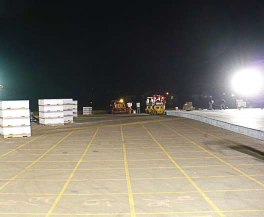San Luis Obispo Opts for Engineered Material Arresting System
During a time when air carriers are cutting service, a recently completed runway project at the San Luis Obispo County Regional Airport is helping keep commercial flights at the California airport.
The two-stage project — an 800-foot runway extension in 2007 and the construction of two engineered materials arresting systems (EMAS) this summer — will allow the airport to be served by regional jets of all sizes.
San Obispo’s primary runway, 11/29, needed to be extended from 5,300 feet to 6,100 feet to meet airline requirements for regional jets, says Mike Shutt, a senior project manager and vice president with Mead & Hunt, the airport’s engineers for more than 10 years.
 The airport simply didn’t have room to expand the runway and keep the required 1,000 feet of runway safety area on each end, notes Klaasje Nairne, the recently retired manager for San Obispo County Airports.
The airport simply didn’t have room to expand the runway and keep the required 1,000 feet of runway safety area on each end, notes Klaasje Nairne, the recently retired manager for San Obispo County Airports.
Using EMAS allowed the airport to provide the needed safety area without purchasing additional land, moving a state highway or impacting a creek.
“The long environmental process of ‘invading’ the creek would still be underway, and moving the highway was just not possible,” Nairne explains. “Plus, property here is very expensive.”
 Without a runway extension, the airport could have lost regional jet service.
Without a runway extension, the airport could have lost regional jet service.
“This was a great project that helped keep us in the air service game,” she says. “Without this project, we would be saying goodbye to our future.”
Instead of the standard 1,000 feet on either side of the runway, the EMAS bed on the departure end of Runway 11 is about 300 feet long and located some 300 feet from runway end. On the other end, the bed is about 312 feet long and 288 feet from the end. That’s about 400 feet less per end.
 Piecemeal Installation
Piecemeal Installation
A contract for the $12 million EMAS project was awarded to Engineered Arresting Systems Corporation (ESCO) in May. ESCO manufactures the only Federal Aviation Administration-approved EMAS technology, called EMASMAX. Installation started in June and the project was finished on July 25.
According to Shutt, the biggest challenge with the installation of the system at San Luis Obispo was accommodating the four carriers that use the single commercial runway.
“The airlines were very reluctant to give up any concessions on their schedules,” he notes. “However, they did agree to cancel a late-night arrival, which allowed the contractor to construct the majority of the infrastructure for the EMAS during an eight-hour, night time, work window.”
In addition to paving the overrun area at night, crews also installed a concrete grade beam in the pavement, which serves as the anchor for the EMAS bed.
 When it came time to install the 4-foot square blocks that make up the EMAS, the airport couldn’t get the late night arrival canceled. Instead, crews worked on the three nights a week that the flight wasn’t scheduled and were able to complete the project two weeks ahead of the eight-week schedule, Shutt reports.
When it came time to install the 4-foot square blocks that make up the EMAS, the airport couldn’t get the late night arrival canceled. Instead, crews worked on the three nights a week that the flight wasn’t scheduled and were able to complete the project two weeks ahead of the eight-week schedule, Shutt reports.
Just a week before the EMAS installation at San Luis Obispo was complete, another EMAS stopped a Mexicana Airlines A320 with 138 passengers after it overran the end of a runway at O’Hare International.
According to Kevin Quan, ESCO’s senior regional director, EMAS have been pressed into service five times and have a “perfect record in successfully saving all five aircraft and passengers.”

“In all cases,” Quan reports, “the aircraft received very minimal damage — such as tire damage — while (there were) virtually no injuries to passengers.”
How it Works
Quan notes that EMAS work differently than other arresting methods.
|
|
“A standard runway safety area relies entirely on surface friction between the aircraft wheels and the surface to get the deceleration needed,” he explains. “In conditions where poor braking is apparent, on rainy days, etc., the standard runway safety area is not as effective in stopping aircraft overrun … EMAS works through the transfer of energy from the aircraft to the EMAS material to slow an aircraft down. Once the aircraft wheels break through the EMAS material, you get a gradual and controlled deceleration.”
Quan also cites installation time and cost as factors to consider. “Compared to a full build out that typically may involve potential environmental impacts, EMAS is a much quicker solution and can easily be installed and provide a safety enhancement in a matter of months,” says Quan.
In contrast, he notes that grading, filling and building out some runway safety areas can cost $20 million or more, depending on the challenges faced.
To date, 28 airports are using 41 ESCO arresting systems. Although San Luis Obispo is the first to use EMAS to facilitate a runway extension, Quan expects more airports to consider the option in the future.
![]()
FREE Whitepaper
PAVIX: Proven Winner for All Airport Concrete Infrastructure
International Chem-Crete Corporation (ICC) manufactures and sells PAVIX, a unique line of crystalline waterproofing products that penetrate into the surface of cured concrete to fill and seal pores and capillary voids, creating a long lasting protective zone within the concrete substrate.
Once concrete is treated, water is prevented from penetrating through this protective zone and causing associated damage, such as freeze-thaw cracking, reinforcing steel corrosion, chloride ion penetration, and ASR related cracking.
This white paper discusses how the PAVIX CCC100 technology works and its applications.








